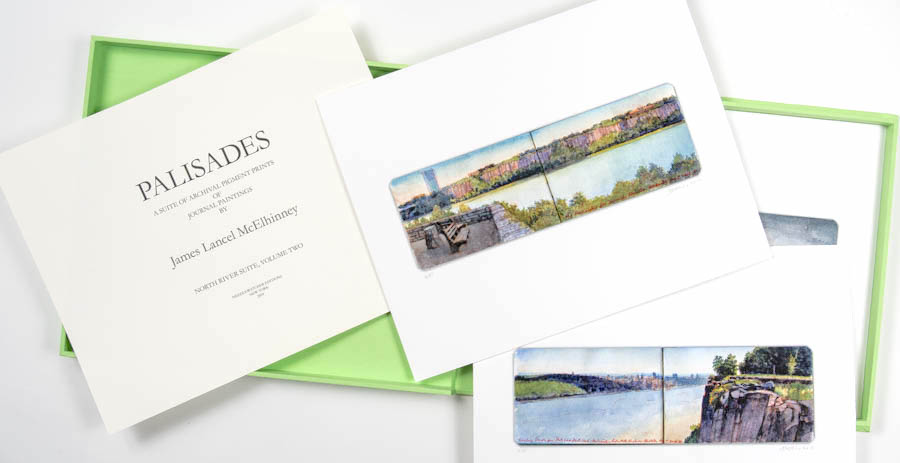
Advance Subscription Offer Extended, due to COVID-19. PALISADES: NORTH RIVER SUITE VOLUME TWO in a limited edition of fifty copies
Projected publication date: November 30, 2020. Retail value 1600.00USD
After much COVID-19 related delays advance copies are now in hand. The first ten subscribers will receive as a bonus a color intaglio print from McElhinney’s 2018 project O.T.W (On the Water): The Schuylkill River, which was the centerpiece of an istallation at Philadelphia’s Indepndence Seaport Museum from October 24, 2018 to January 5, 2020.
Reserve a copy by becoming a VIP Advanced Subscriber for 900.00USD
Deposit required: 450.00USD. (Balance due prior to delivery)
New York Residents add 08% sales tax. Reserve your copy now by writing to editions@needlewatcher.com Subject-line: “Palisades”
The subscription price will be honored prior to the publication date.
To pay by credit card call 347-266-5652
Or pay by check: Payable to Needlewatcher LLC. PO Box 233. Essex. New York. 12936-0233
Click on PREVIEW
Back to PUBLICATIONS
KATHERINE MANTHORNE SPEAKING AT “FAIRE OEUVRE” COLLOQIUM, MUSEE D’ORSAY
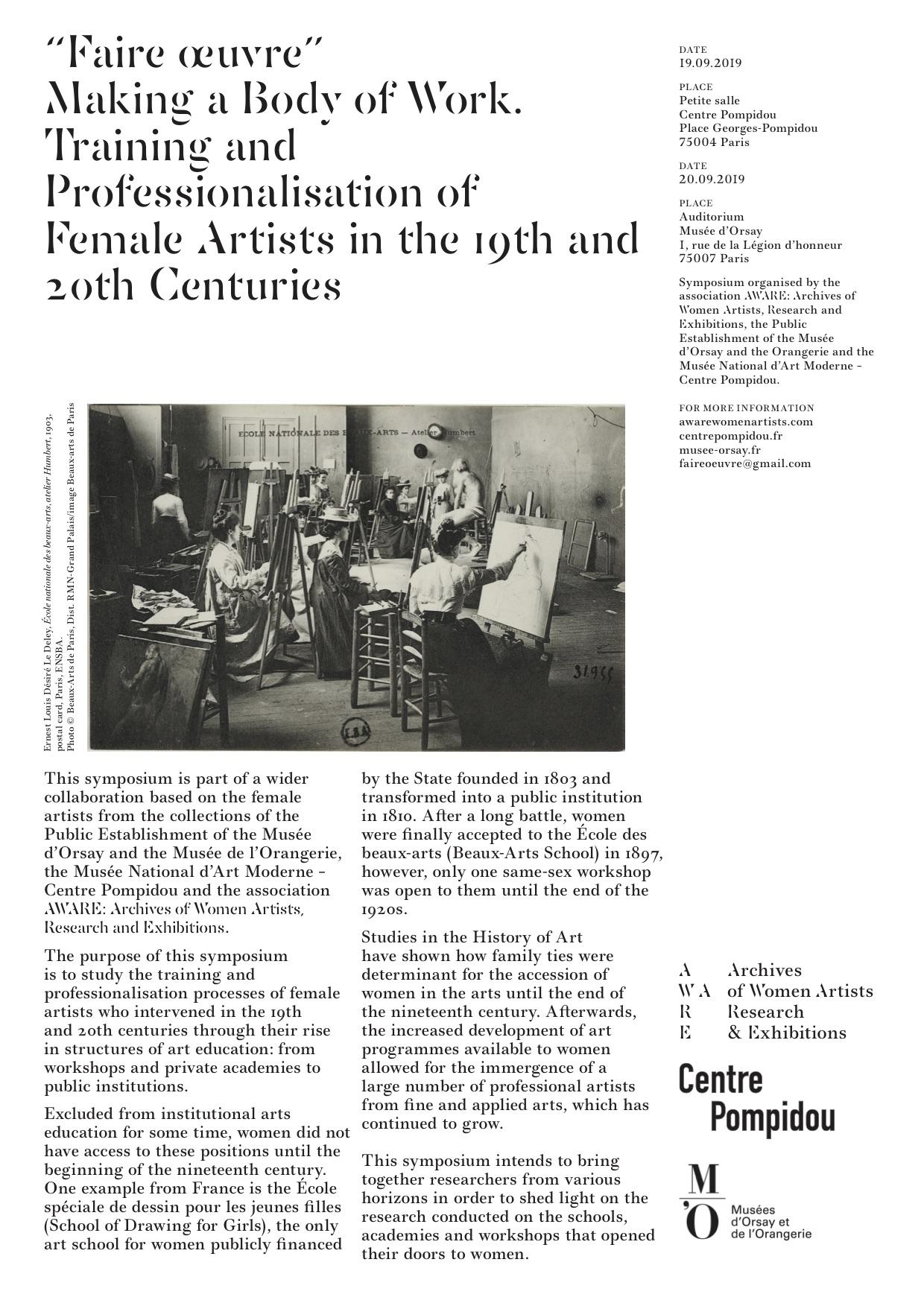
On September 19-20 Centre Georges Pompidou and Musee d’Orsay in Paris will host a two-day colloquium on the education of women as artists in 19th-century Paris. Manthorne will address the subject in relation to Irish-born Eliza Pratt Greatorex (1819-1897) and her American daughters. Manthorne’s biography of Greatorex is being published by University of California Press.
Please consult the PDF below for details:
ParisSymposiumWomenSept19
OPENING THURSDAY SEPTEMBER 12, HUDSON RIVER MUSEUM

James McElhinney: Discover the Hudson Anew. Hudson River Museum. 511 Warburton Avenue. Yonkers, New York. 10701. September 13, 2019 to February 16, 2020
Preview the exhibition by clicking on this link. https://www.hrm.org/exhibitions/discover-the-hudson-anew/
This exhibition will pair (and compare) painting-journals and prints by James Lancel McElhinney with historical precursors such as William Guy Wall, Jacques-Gerard Milbert, Samuel Colman, and the late Don Nice. McElhinney considers research, travel, writing and drawing as integral to his artistic practice. Inspired by explorer-artists and naturalists such as Jacques le Moyne, John White, Joshua Rowley Watson, Pavel Svin’in, John-James Audubon, George Catlin, Richard and Edward Kern, Seth Eastman, Frederic Edwin Church, Albert Bierstadt, Thomas Moran and Auguste Morisot, McElhinney has reinvigorated the historic expeditionary practice of topographical sketchbook-painting.
KATHIE MANTHORNE SPEAKING AT MAINE MARITIME MUSEUM ON APRIL 6

Dr. Katherine E. Manthorne of the CUNY Graduate Center doctoral program in art history will open the 46th Albert Reed Thelma Walker Maritime History Symposium at the Maine Maritime Museum with a talk, “The Liquid Mystic Theme” in American Art: Shifting Perceptions of the Sea”.

Link:
https://www.mainemaritimemuseum.org/event/46th-albert-reed-thelma-walker-maritime-history-symposium/
Downloadable PDF:
Maritime Symposium Flyer
GROUNDBREAKING NEW BOOK ON THE CINEMA & AMERICAN MODERN ART

“Between the 1890s and the 1930s, movie going became an established feature of everyday life across America. Movies constituted an enormous visual data bank and changed the way artist and public alike interpreted images. This book explores modern painting as a response to, and an appropriation of, the aesthetic possibilities pried open by cinema from its invention until the outbreak of World War II, when both the art world and the film industry changed substantially. Artists were watching movies, filmmakers studied fine arts; the membrane between media was porous, allowing for fluid exchange. Each chapter focuses on a suite of films and paintings, broken down into facets and then reassembled to elucidate the distinctive art–film nexus at successive historic moments.”
–Katherine Manthorne
Dr. Katherine E. Manthorne is a writer, scholar, and professor in the Doctoral Program in Art History, at the Graduate Center of the City University of New York, specializing in Art of the United States and Latin America. She is a graduate of Barnard College and Columbia University. Formerly head of the Art History Department at University of Illinois at Champain-Urbana, Manthorne directed the Office of Research at th4 Smithsonian American Art Museum and edited the journal American Art before joining the CUNY Graduate Center faculty. She recently curated the exhibition California Mexicana at the Laguna Museum, as part of the Getty Foundation PST2 cycle of exhibition, and was guest curator for the exhibition The Rockies and the Alps at Newark Museum. Manthorne was the first professor of American Art at University of Venice Ca’Foscari, Terra Foundation Distinguished Visiting Professor at the Free University in Berlin, Tyson Scholar at Crystal Bridges Museum of American Art. She is the author, editor and co-author of numerous essays and books including Tropical Renaissance, The Landscapes of Louis-Remy Mignot, Luminist Horizons: The Art and Collection of James A. Suydam (With Mark Mitchell), Traveler Artists. Landscapes of Latin America from the Collection of Patricia Phelps de Cisneros (editor), California Mexicana: Missions to Murals (editor), The Rockies and the Alps: Calame and the Romance of the Mountains(with Patricia Bloom), and a contributor to numerous other books
Amazon.com (more buying options)
https://www.amazon.com/Film-Modern-American-Art-Routledge-ebook/dp/B07NBSCXXC/ref=sr_1_1?keywords=katherine+manthorne&qid=1552918775&s=gateway&sr=8-1&fbclid=IwAR2gj2015Rk7iU6wP4ROssuNgM7GDTjdjqBfgH3BZ0QbcMEn5j5VvXKY1Ak
FOLLOW-UP ON CAA WORKSHOP: ARTISTS AS PUBLISHERS

Thanks to everyone who attended the Artists as Publishers workshop on Thursday February 14 at 11 am, in Americas Hall II at the Midtown New York Hilton. I hope everyone found the talk stimulating and informative
The projects I unpacked are a new iterations of an old concept. My reason for sharing so much was not entirely selfless. Let’s look at this workshop as a loss-leader, a way to inspire other artists to undertake similar projects in the hope of developing new audiences and growing new markets.
Please bear in mind that in the business of trade and art-publishing, there is no way to turn merit and peer-review into income. The challenge always is to produce a beautiful and engaging product that will win support in the marketplace. But somehow, one must find a way to be compensated for the many hours of research and development leading up to production and publication. It would probably take half a dozen successful projects to recover those costs. That said, it would be folly to even consider fine press art-publishing as a business, unless one is in it for the long haul.
As promised, here is a PDF of the PowerPoint. Please feel free to use it as a reference guide, with the caveat that the presentation is protected by copyright, and may not be reproduced without written permission from Needlewatcher Editions, a DBA of Needlewatcher LLC,a bonded New York State registered Limited Liability Company. PO Box 142, West Haverstraw, New York, 10993-0142. editions@needlewatcher.com
CAA Artists as Publishers 2019_Webpost
Special Offering: Framed Artwork from HUDSON HIGHLANDS, with Exhibition Provenance
HUDSON HIGHLANDS: NORTH RIVER SUITE VOLUME ONE. Needlewatcher Editions. 2017.
SPECIAL OFFER: Artworks with Exhibition Provenance
Needlewatcher Editions is pleased to offer a set of seven archival pigment prints that were exhibited in the exhibition Wish You Were Here, Journals, Journeys and Exhibitions, curated by Martha Willette Lewis at the Institute Library in New Haven from June 2 – August 31, 2018. Framed and ready for hanging, the prints, mat and frames consist of archival materials.

Installation view of the exhibition. Curator Martha Willette Lewis speaking with Yale Art Gallery Holcombe T. Green Curator of American Art Mark Mitchell, seen on the right with Dr. Katherine E. Manthorne of the doctoral art-history program at CUNY.

Works for sale are seen hanging on the wall above the vitrines. Wall labels and a letter of authenticity signed by the artist are included in the sale.

Hudson Highlands, North River Suite Volume One, was published by Needlewatcher Editions in November 2017 and has been exhibited at the Institute Library in New Haven and at Boscobel House and Gardens in Garrison. New York. Copies of the deluxe limited edition now can be found in the collections of
Albany Institute of History and Art
Avery Fine Art and Architecture Library, Columbia University
Boscobel House and Gardens, Garrison, New York
University of Denver. Library Special Collections. Denver Colorado
Hudson River Museum, Yonkers New York
Huntington Library and Museum, San Marino, California
Newberry Library. Chicago, Illinois
New York Public Library
West Point Museum, United States Military Academy
Yale Beinecke Rare Book and Manuscript Library. New Haven Connecticut
On February 1, 2019, the Institute Library set will be offered for sale as a whole. Each framed print is certified as authentic by the artist, along with wall-labels from the exhibition) for the price of $1,600.00.
Prior to that date, the price is $1,200.00. (New York residents add 8% sales tax) Pack & ship: $25.00
Personal check, credit cards and PayPal accepted.
To order: email editions@needlewatcher.com or call 1-347-266-5652. All sales are final.

South Gate from Bear Mountain

West Point from Garrison’s Landing

Looking Southwest from Boscobel

The Western Highlands from Boscobel

Crow’s Nest from Cold Spring

Crow’s Nest and Storm King

The North Gale from Cold Spring Landing
Reviving a Lost Art
Inspired by expeditionary artists from Jacques le Moyne and John White to Seth Eastman and the brothers Kern, McElhinney has revived the practice of journal-painting during trips to Europe, Hawaii, Ecuador, Peru, California, the Rocky Mountains, the American Southwest, and throughout the Hudson Valley. Following in the footsteps of William Guy Wall, Jacques-Gérard Milbert, Thomas Cole, Frederic Church, Nathaniel Parker Willis, Washington Irving, John Burroughs and others, McElhinney’s narrative parallels The Hudson from the Wilderness to the Sea, an 1866 book by travel-writer and artist Benson J. Lossing. McElhinney regards each of his painted books not just as collections of discrete images, but as intimate, time-based works in their own right.

Debossed handcrafted clamshell box and chapbook deluxe limited edition. A few copies remain.
Current retail price is $1,800.00. As part of this special offer, copies of the boxed set can be purchased at the publication-date price of $1,500. This offer expires February 15, 2019
The Artist
James Lancel McElhinney is a visual artist, author and oral historian. McElhinney attended Tyler School of Art, Skowhegan School of Painting and Sculpture and Yale, where he earned an MFA in painting. McElhinney is a recipient of a 2017 Pollock-Krasner Grant., and a previous fellowship from the National Endowment for the Arts. McElhinney is listed on the Master Artist Council of the Arthur Miller Foundation. He has just signed a contract with Schiffer Books to produce a new series; The Sketchbook Traveler, a field guide to mindful journeys exploring how drawing and journal-keeping deepens one’s experience of and engagement with the worlds around us in ways that transform personal experience into durable knowledge. McElhinney is now preparing for a solo exhibition at Gerald Peters Gallery in Santa Fe, and a new series on the Rio Grande in New Mexico, and volume two of North River Suite: The Palisades: Weehawken to Piermont. Website: www.mcelhinneyart.com
Please address all enquiries to editions@needlewatcher.com, or call +1 347-266-5652
Downloadable PDF:
HUDSON HIGHLANDS_Framed art sale
“ON THE WATER: THE SCHUYLKILL RIVER” INSTALLATON BY JAMES LANCEL McELHINNEY AT INDEPENDENCE SEAPORT MUSEUM IN PHILADELPHIA
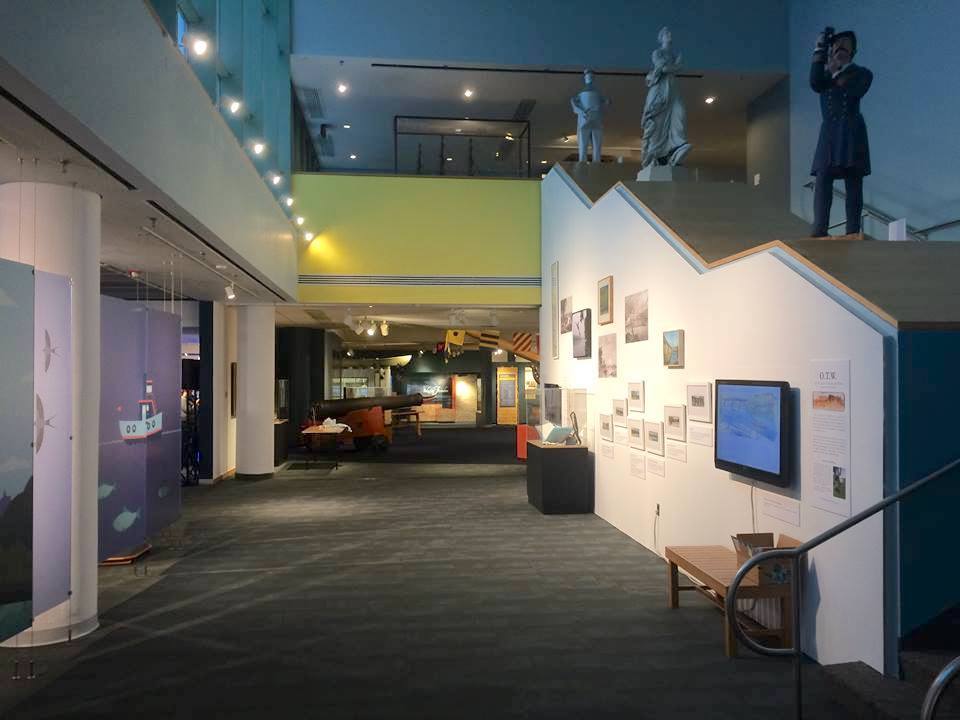
O.T.W. On the Water: The Schuylkill River, an installation at Independence Seaport Museum in Philadelphia, was conceived as a monographic show about my 2018 journal-painting project.
As the work developed, my research deepened. I realized that there was no way for me to do justice to my subject–the river–without bringing more artists into the conversation. Chief curator Craig Bruns was a terrific thought-partner, open to letting the process unfold, leading us beyond conventional paradigms to a gesamtkunstwerk.
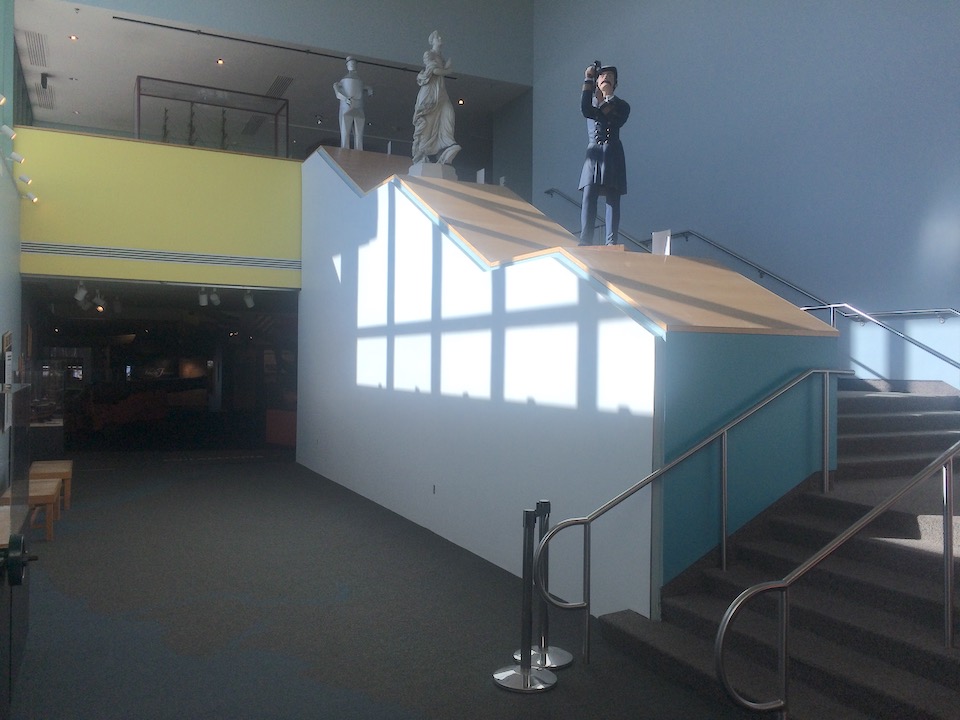
View of the space, prior to resurfacing the wall and installing the exhibition
The result is the surprising use of a challenging surface. Reaching across time and media, from oil painting, digital and intaglio printmaking, to documentary film and video animation, the exhibition design by Daniel Kennedy brings together works by historic artists Edmund Darch Lewis, Johann Georg Martini and Granville Perkins, with living artists Patrick Connors, < a href="http://www.tomjuddart.com">Tom Judd, Stacy Levy, Deirdre Murphy, Jacob Rivkin, Joseph Sweeney and Graham White. When the curtain fell, revealing the River Alive!] across the corridor, it all made sense. It is a great privilege to collaborate with so much talent. Let’s take a virtual tour of the exhibition: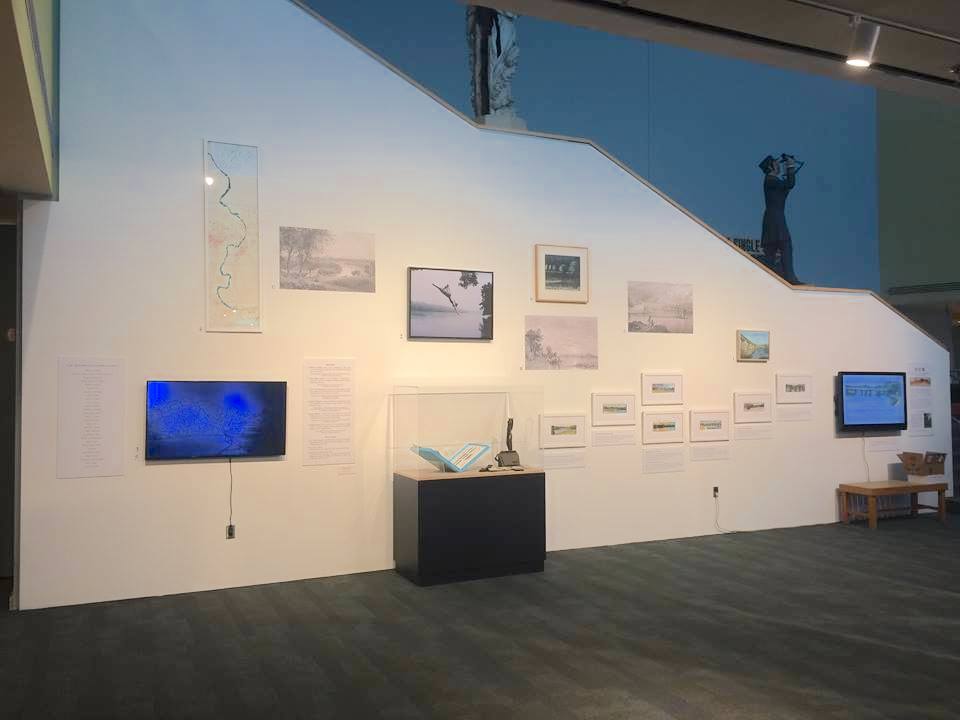
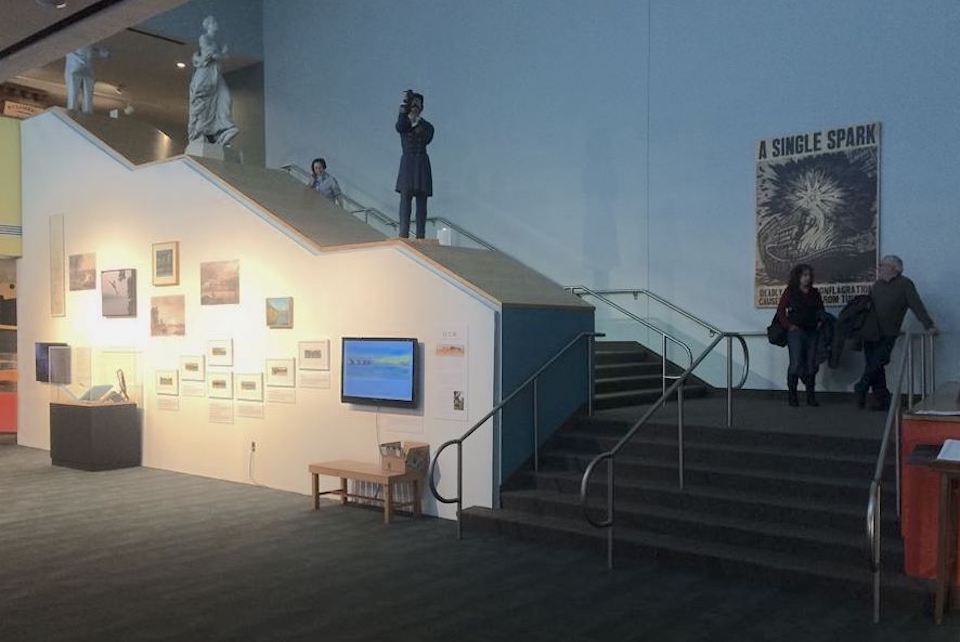
The space was challenging. We were not working with a conventional white box. As my work progressed and the vision took shape, I would joke with Craig Bruns and Daniel Kennedy that the exhibition would be something like figuring out what to do with a basket of secret ingredients on a competitive cooking show. Located opposite the galleries being readied for River Alive!, the wall flanked a grand staircase leading up through a glass atrium to the second floor displays. I had seen a similar configuration before, on an even grander scale at Museum of Fine Art Houston.
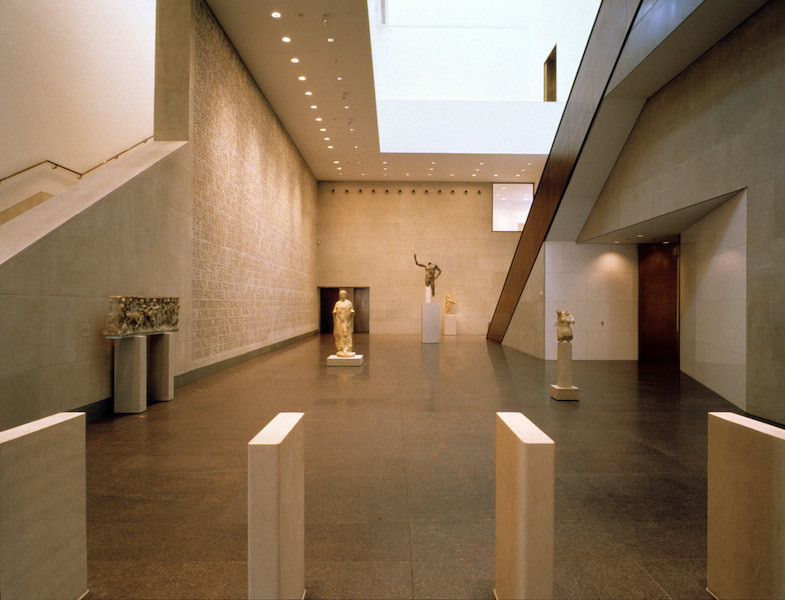
The planning process was emnbraced with a collaborative spirit. Craig and Dan knew the space. They worked with it on a daily basis. The one decision In which I participated concerned the 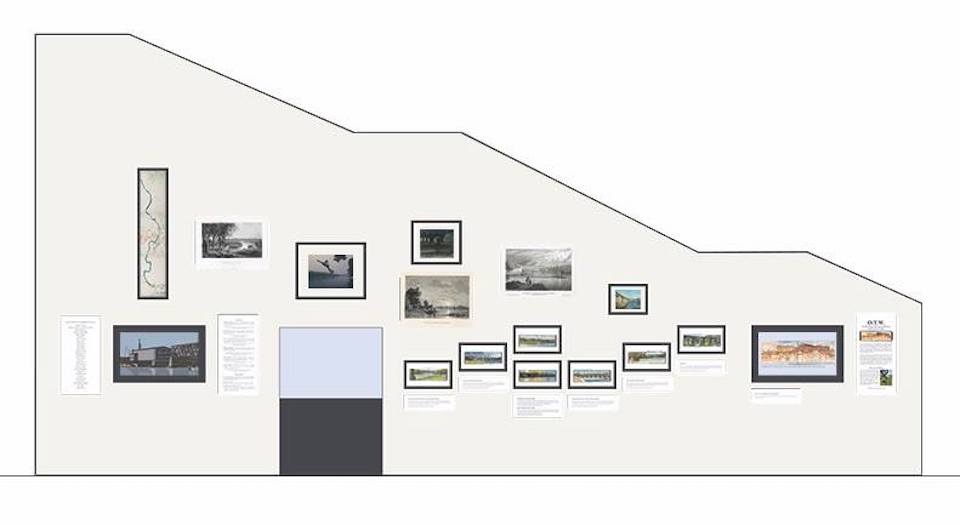
In preparing the language to accompany the exhibition, I asked Craig how I should be identified. This was no longer a one-person show, but a thematic exhibition curated by an artist. Should I be identified as a guest curator? No, Craig replied. That would be too confusing. He was the chief curator. You’re the artist, he told me. Other artists are in it, but this is your show. His solution was to call it an installation by James Lancel McElhinney. I thought about that for a minute, and then asked if if that meant I was now an installation artist. We both laughed. What’s in a name? More important to me was the sentiment expressed by Stacy Levy, inaugural artist for Art@Bartrams. On view in our exhibition is a film produced by Bartram’s Garden and Mural Arts Philadelphia, documenting the installation of Levy’s Tide Field project. In it Levy states,
“Im trying to make a work that brings people down to meet the river, see the changes, so they might get to known it, and then they’ll get to love it, and then they’ll want to preserve it”
Sketches emailed back and forth. Dan developed the grand plan incorporating my suggestions, not because it was the will of the artist, but because they solved a problem with design sense. The only thing I insisted on was for Dan to be credited as one of the artists in the show, for his imaginative transformation of a difficult space. (below)
/46345817_2218058305141887_6246546567822573568_n.jpg” alt=”” width=”960″ height=”720″ class=”alignnone size-full wp-image-3176″ />
Moving from right to left along the wall, as one would upon entering the building, is an introductory text-panel, to the left of which is a wall-monitor displaying a digital animation of my Schuylkill River sketchbook.
[video width="1920" height="1080" mp4="http://www.mcelhinneyart.com/jlmcelhinney/wp-content/uploads/2018/12/otw_mcelhinney_102218_final.mp4"][/video]
Continuing leftward are seven framed archival pigment prints, unpacked from my new book (O.T.W. The Schuylkill River. Needlewatcher Editions. New York. 2018), hung according the plan already described. Above them, from right to left, is a painting in oil by Patrick Connors, followed by 1830 engraving of the Colossus (Spring Garden Street) Bridge by Johann Georg Martini, enlarged and applied directly to the wall. Below and to the left is a similar enlargement of a nineteenth-century view of the Schuylkill River by Edmund Darch Lewis. Above it is an intaglio print by Joseph Sweeney.
Scroll down to view all the works:
O.T.W. The Schuylkill River (Archival pigment prints)
LOOKING SOUTH FROM BELOW THE CONNECTING RAILWAY BRIDGE
Facing northwest, sheltered by the arches of the Pennsylvania Railroad Connecting Bridge on a rainy day. Kelly Drive is to the right. A bike-trail runs beside it. Schuylkill Expressway roars behind the western bank, MLK Drive and Dragon-Boat dock, on the wooded shore beyond. A solitary rower moves downstream.
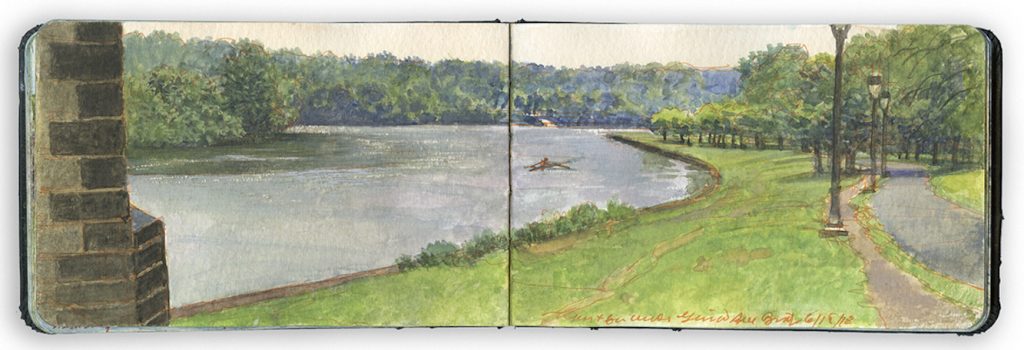
LOOKING SOUTH FROM THREE ANGELS
A broad esplanade on the eastern bank was created when landfill replaced pestilential wetlands. A grove of cherry trees was created from a gift to the city by Japan, honoring the sesquicentennial of American independence. Rising behind the Connecting Railway Bridge is the distant form of the Comcast Technology Center.
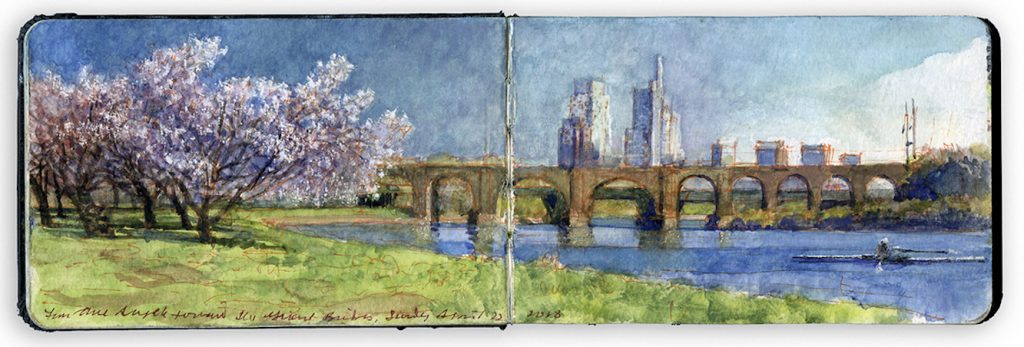
LONE OARSMAN PASSING THREE ANGELS
Standing on the western shore of the river below the Dragon Boat Dock, looking southwest. Imagine being in the middle of the river, where Thomas Eakins envisioned Max Schmitt, at rest in his single scull. Passing Three Angels, a lone oarsman pulls downriver toward stone arches, the Connecting Railway Bridge
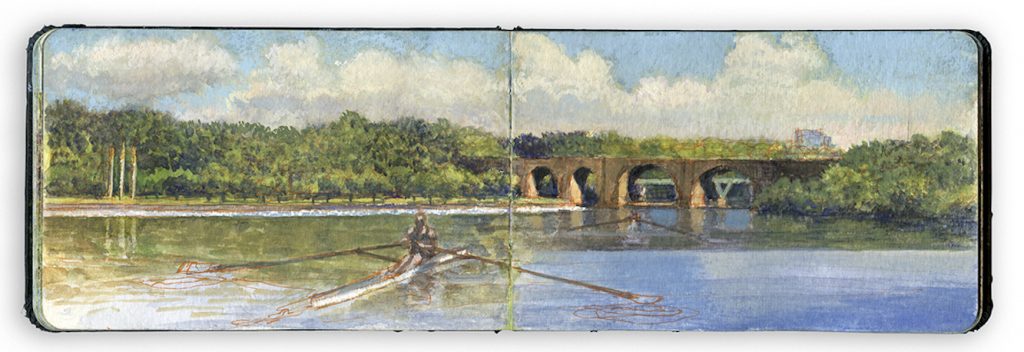
SUNSET: COLUMBIA RAILROAD BRIDGE
Getting on the water before work marks a tradition dating from the nineteenth century. Social diversity is an enduring trait of amateur competitive rowing. CEOs and plumbers, men and women, young and old. Mind, body, time, and the river, all become one, in greeting the day or bidding it farewell.
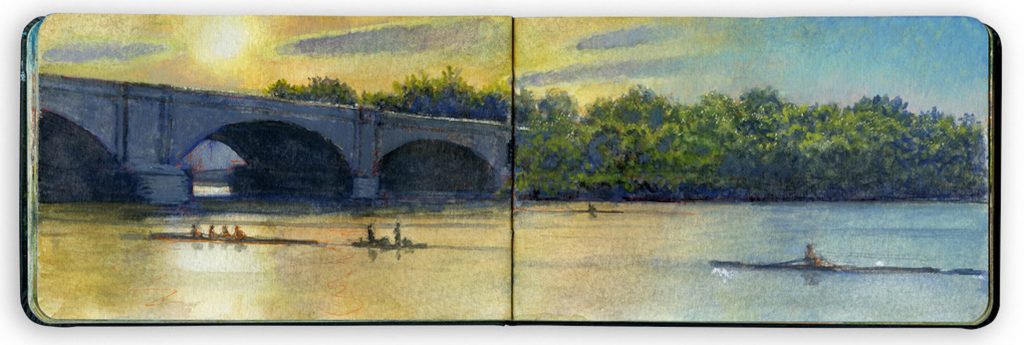
LOOKING DOWNSTREAM TO COLUMBIA RAILROAD BRIDGE
Marking a point halfway between Philadelphia Museum of Art and East Falls, Columbia Railroad Bridge was constructed in 1920. A grandstand for watching Schuylkill Navy regattas sits just upstream. Behind the distant tree-line is Memorial Hall. Built for the 1876 Centennial Exposition, it now houses The Please Touch Museum.
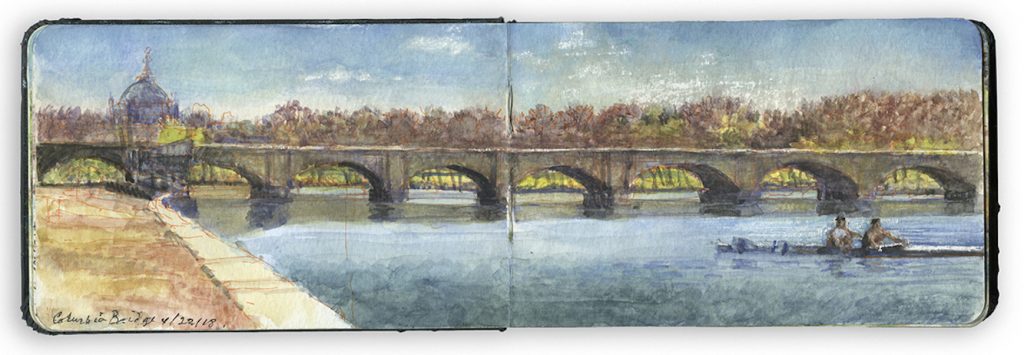
BELOW STRAWBERRY MANSION BRIDGE
Built in 1897, filigree steel arches soar above the river, connecting the eastern and western sections of Fairmount Park. Competing crews assemble upstream at a chain of pontoon boats. The race begins. Passing under the bridge, slender hulls glide upon the water on their way downstream to the finish line.
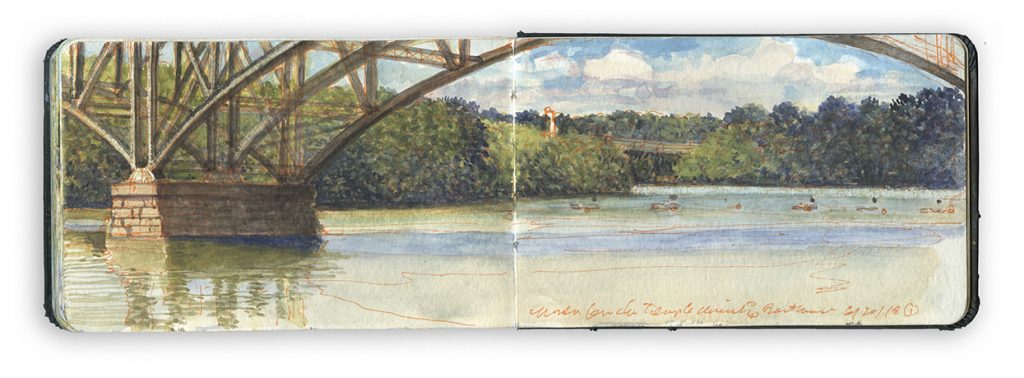
TWIN STONE
Known to rowers as “Twin Stone”, for many these bridges mark the northern limit of their range. Submerged rocks bid a cool welcome, yet some venture upstream, to enjoy the calm waters below Manayunk. While I painted this scene, three snapping-turtles appeared offshore, in a patch of bright sunlight.
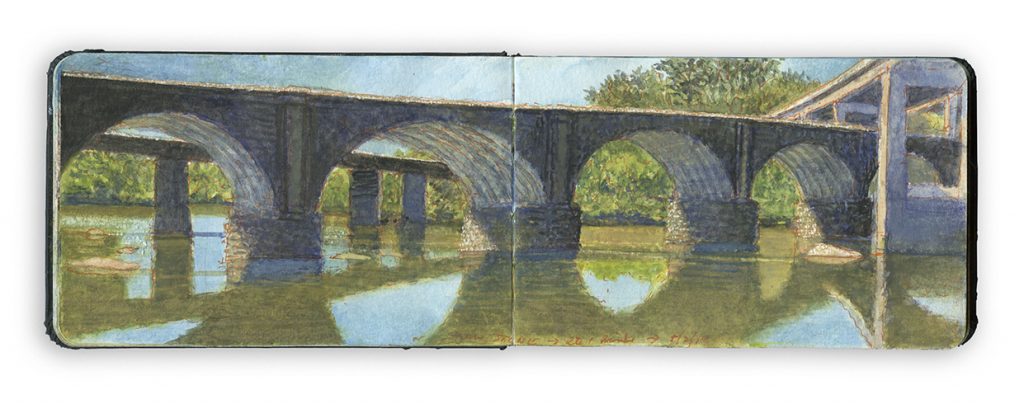
PATRICK CONNORS
Late Winter, Philadelphia & Reading Railroad Bridge, 14” x 18” [framed], oil on linen, 2017
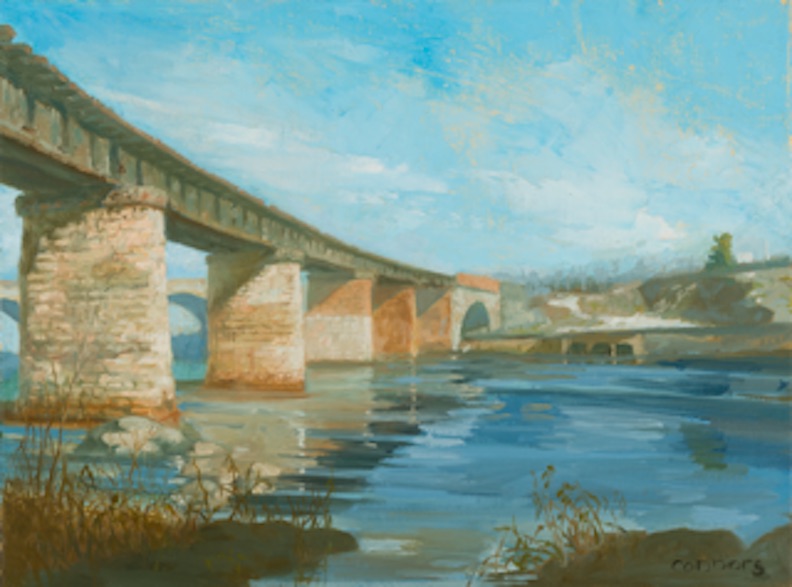
JOHANN GEORG MARTINI. Die Grosse Brücke über dem Schuylkill bey Philadelphia, Ver: Staaten. (The Colossus Bridge over the Schuylkill River in the City of Philadelphia). Steel engraving by J.G. Martini, Rudolstadt, Thurginia, Germany. Publisher: Figenthum. 1833. This view of the Colossus Bridge, with Fair-Mount behind, and the Water Works on the far shore beyond is from the west bank, looking northeast. The 340-foot wooden covered bridge was constructed in 1812 and destroyed by fire in 1838. Spring Garden Street Bridge now spans the river at the site.
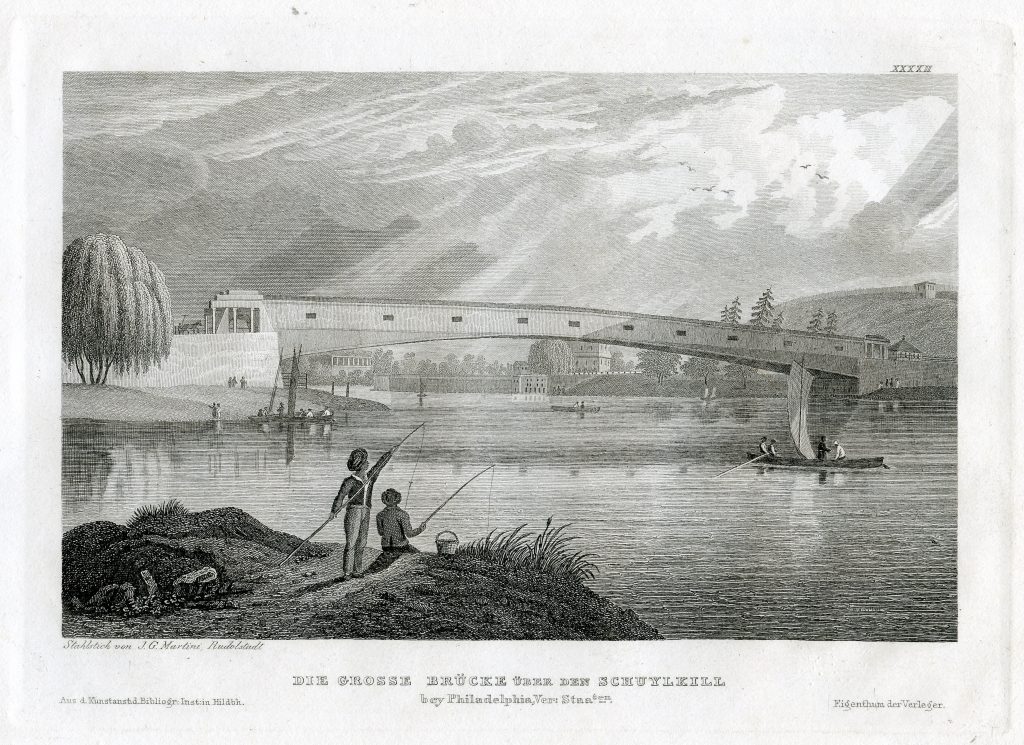
EDMUND DARCH LEWIS (1835-1910). Scene on the Schuylkill. Steel engraving by P. Seleé.This focal point of this romanticized view of the river shows. The rescue of a family dog would have appealed to a mid-19th-century appetite for sentimental genre scenes. Unlike other scenes of the Schuylkill, the location is ambiguous. Submerged trees and grassy sandbars give a sense of the river’s character before its banks were girded with long esplanades
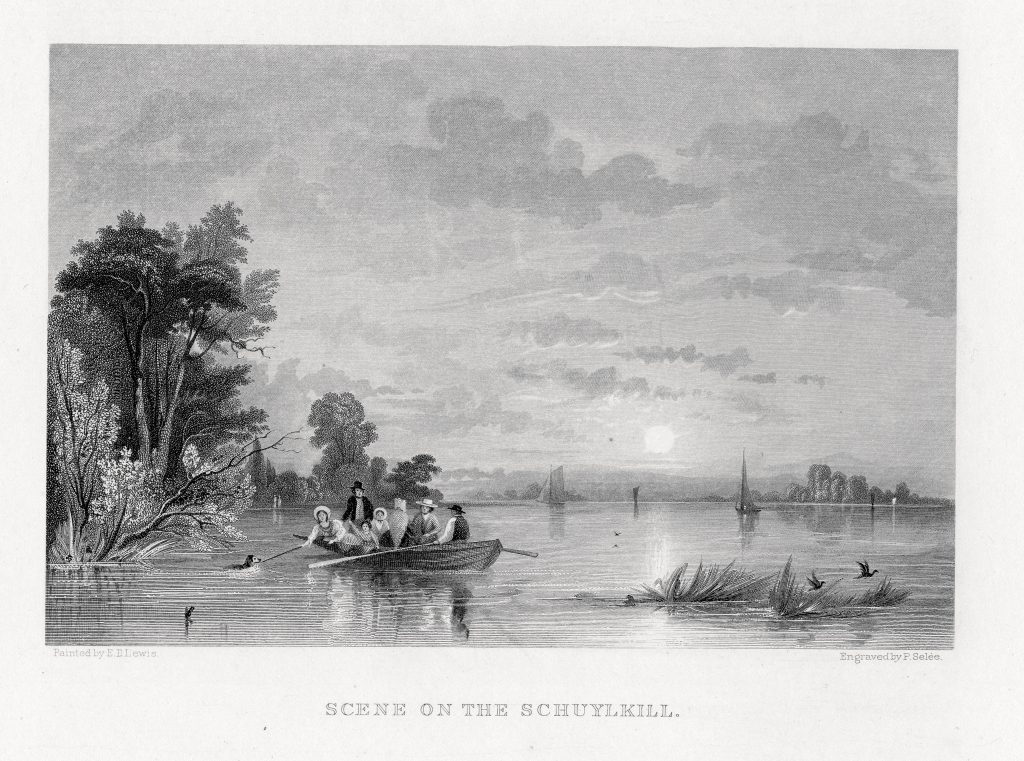
JOSEPH SWEENEY
“Light into Shadow” 6/50 Color etching.13.5”x15.5” framed size 22×23” © Joseph Sweeney 1985
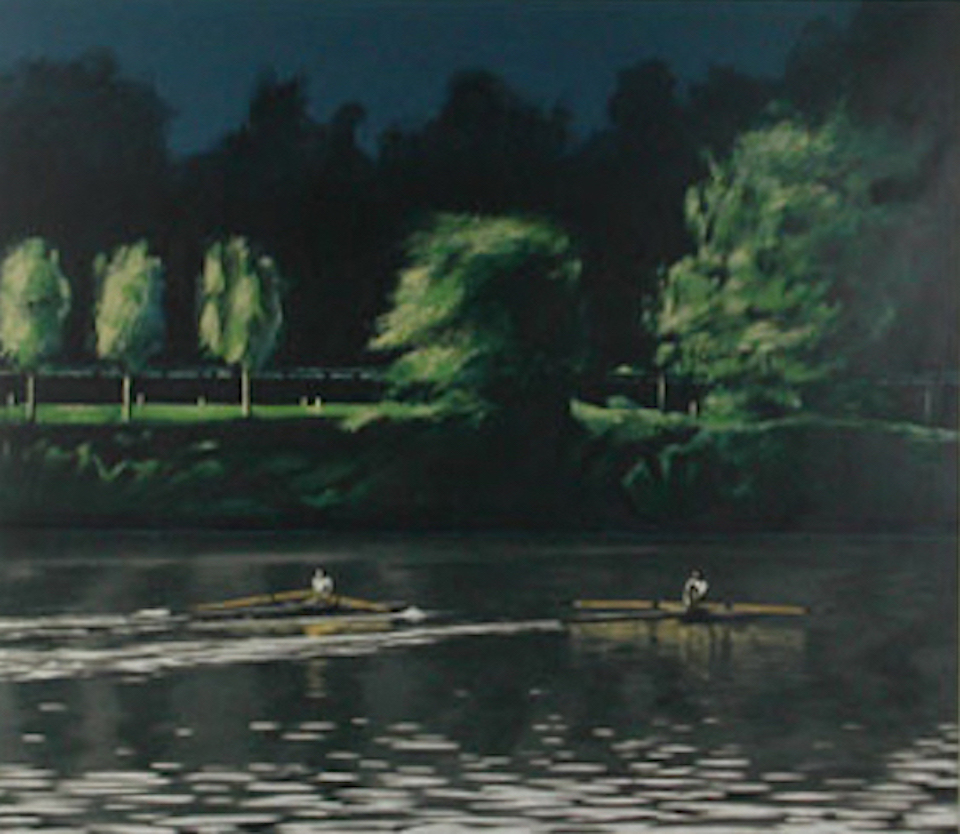
Here the wall is divided by a large vitrine, containing the Solander box which acts as the binding for the limited-edition of O.T.W. The Schuylkill River, together with artifacts of my journal-painting practice: shoulder-bag, watercolor box, brushes, pens and candid photographs documenting my fieldwork.
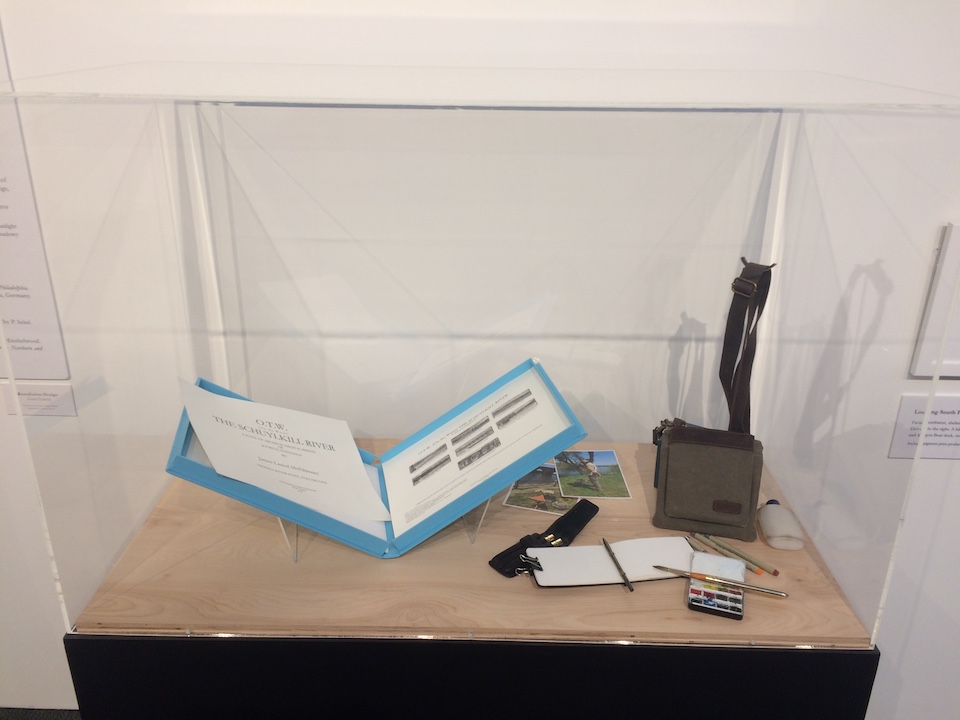
Vitrine containing the Solander box, title page and colophon for O.T.W.The Schuylkill River, with McElhinney’s journal-painting field-equipment.

Solander box, title page and colophon for O.T.W.The Schuylkill River, limited edition of fifty. Needlewatcher Editions. New York, 2018. Produced by Brilliant Graphics, Exton PA and Shenzhen, China.
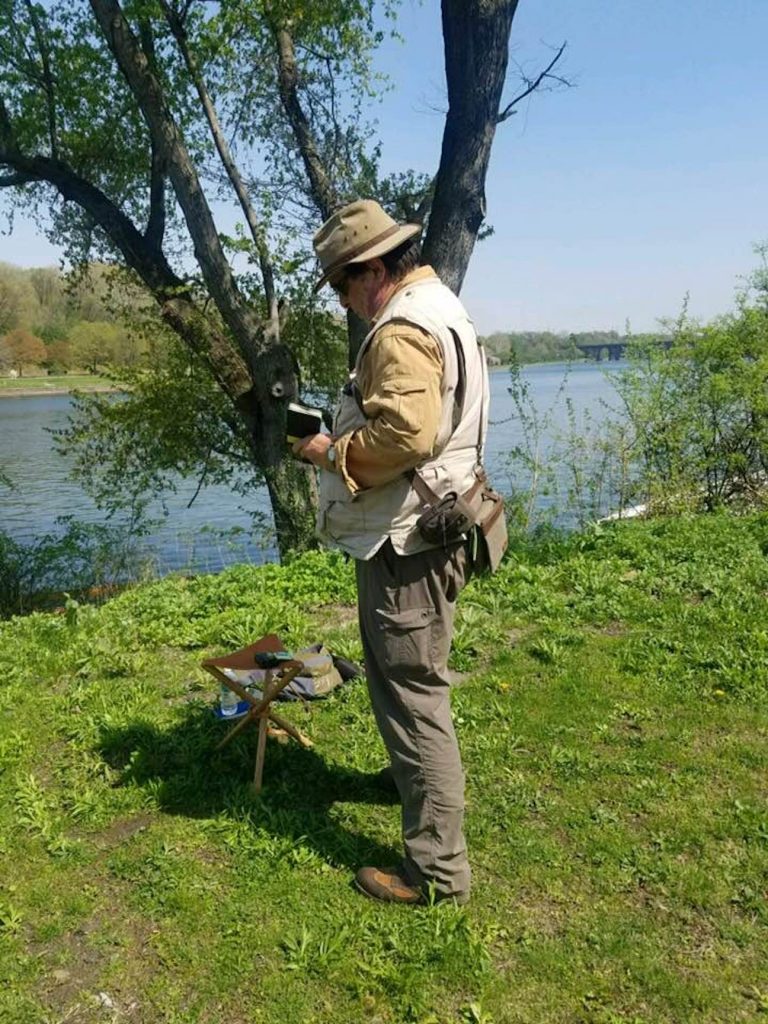
James Lancel McElhinney at work along he western bank of the Schuylkill near the Dragon-Boat dock
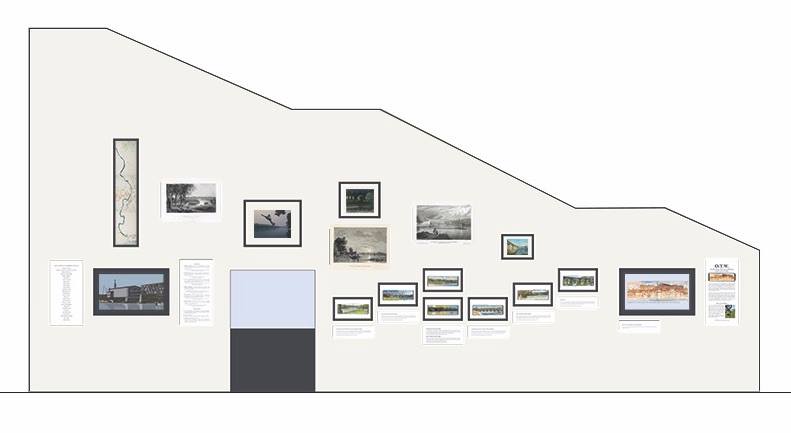
Directly above the vitrine is an archival pigment print on canvas:
TOM JUDD. River Bank. Archival digital print on canvas. 34 x 26” 2018
Website: www.tomjuddart.com
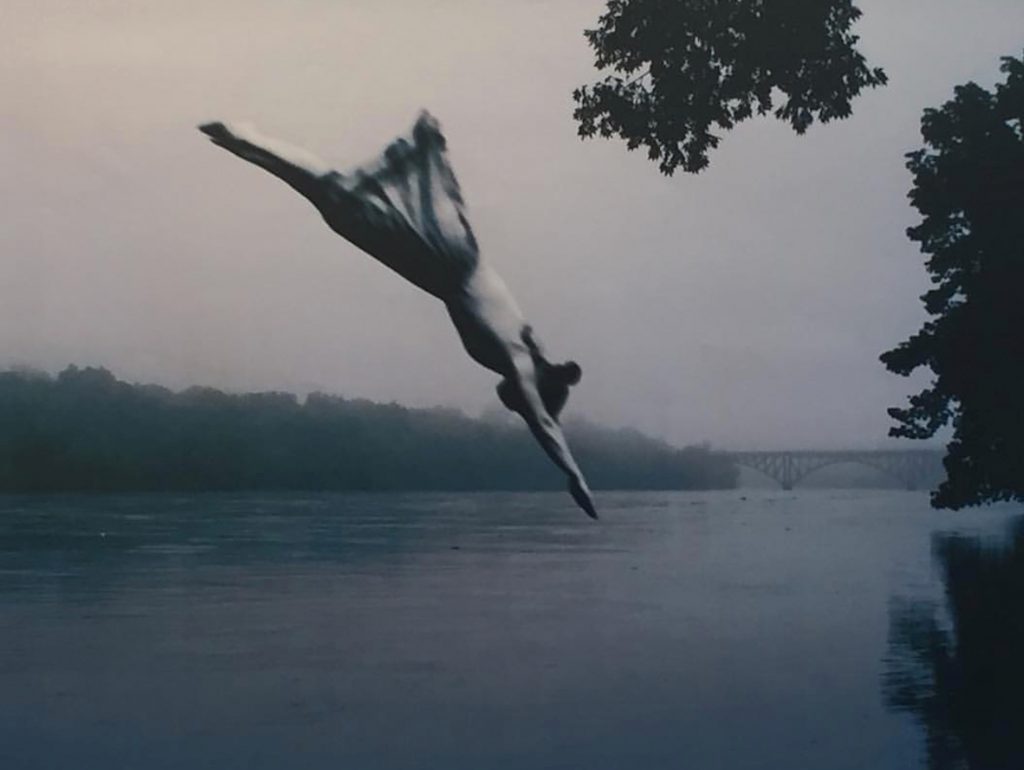
To the left is a text-panel identifying works by River Artists Patrick Connors, Tom Judd, Stacy Levy, E.D. Lewis, J.G. Martini, Deirdre Murphy, Granville Perkins, Jacob Rivkin and Joseph Sweeney.
Below is a downloadable PDF of all exhibition texts.
[gview file=”http://www.mcelhinneyart.com/jlmcelhinney/wp-content/uploads/2018/12/Text-Graphics-2_ISM.pdf”]
Directly above the text panel is an enlargement of a steel engraving, which like the J.G. Martini and E.D. Lewis, is applied directly to the wall as a decal:
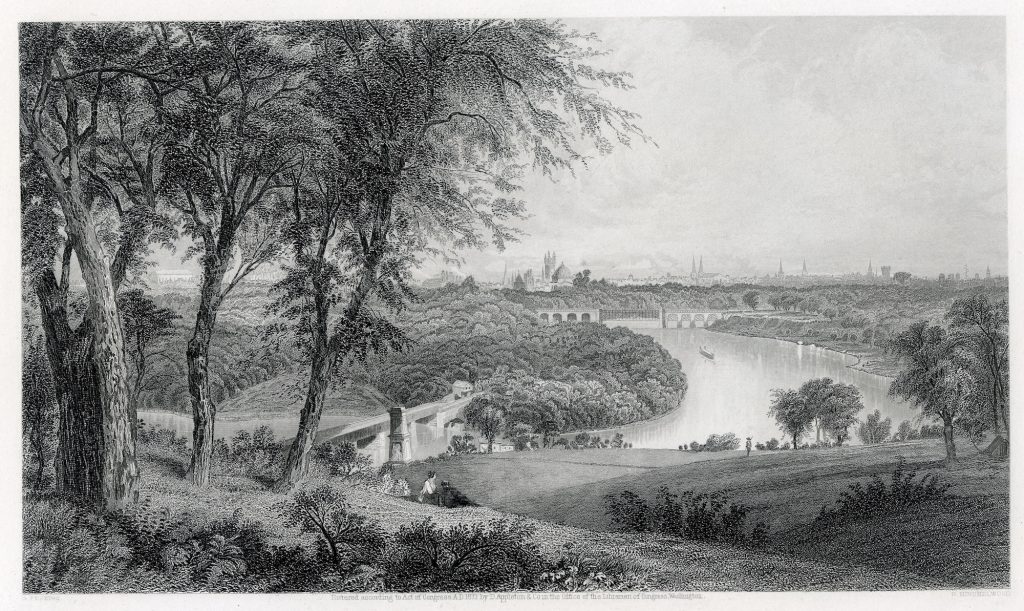
GRANVILLE PERKINS (1830-1895) Philadelphia from Belmont (West Park).Engraved by R. Hinshelwood. Williams, W. Appleton’s Handbook of American Travel: Northern and Eastern Tour. New York. 1870.This plate from Appleton’s second edition of the travel-guide covering Philadelphia Below is the first Columbia Railroad Bridge, built in 1834. In the distance is the 1867 Pennsylvania Railroad Connecting Railway Bridge. Two great stone arches replaced its central truss in 1912-1915, when the viaduct was widened from two tracks to five.

To the left is located another video wall-monitor, running two films:
STACY LEVY: Tide Field: Art on the Schuylkill. 2018.
View the film
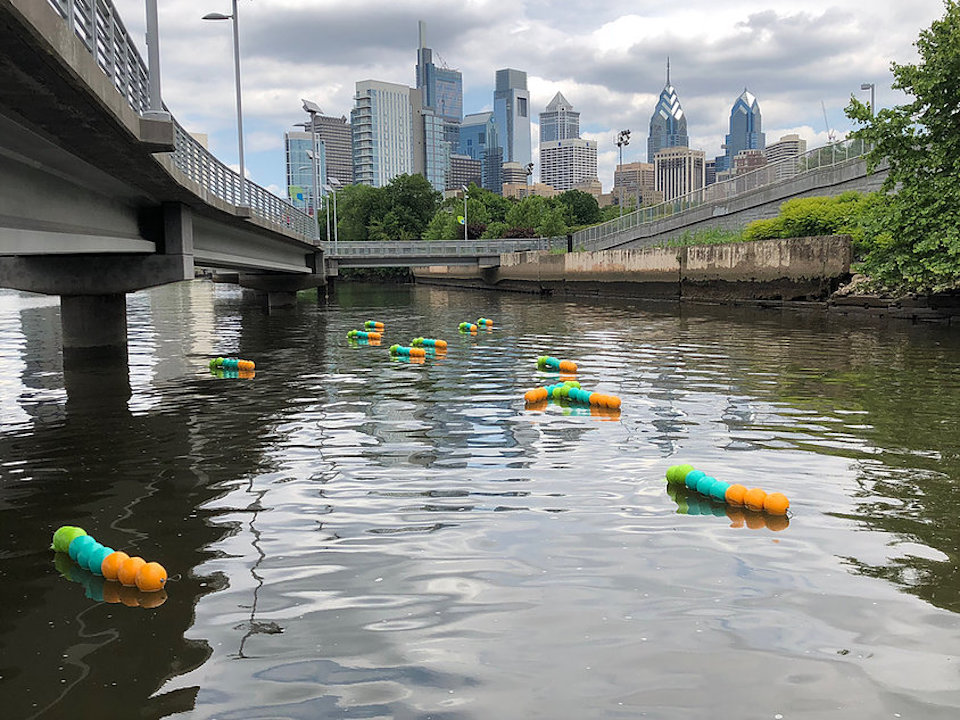 Courtesy Mural Arts Philadelphia and Bartram’s Garden
Courtesy Mural Arts Philadelphia and Bartram’s Garden
Website: www.stacylevy.com
JACOB RIVKIN.Floating Archives. 2018, Hand-drawn digital animation, field recordings, 6:00 minutes
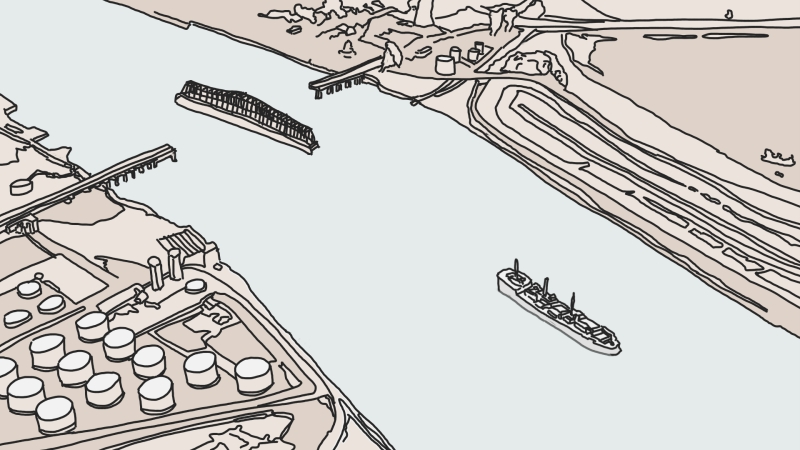
This compilation of animations was featured in the public artwork Floating Archives on the lower Schuylkill River in September 2018. Based on archival photographs and drawings, these animations were projected on screen suspended between two canoes as the watercraft traveled northwards from Bartram’s Garden in southwest Philadelphia to the dam at the Fairmount Water Works below the Philadelphia Museum of Art. This film is organized spatially, reimagining the labor, leisure, and obscured histories of this waterway from 1800 to today. Website: www.jacobrivkin.com
Above the monitor to the left is an intaglio print produced with Philadelphia master-printer Cindi Ettinger.
DEIRDRE MURPHY
Mapping Movements: The Invisible Highways of Urban Birds at the Waters Edge.
60″h x 14″w. Etching and Chine Colle on Japanese Rice Paper. 2018. Printed by C.R. Ettinger Studio.
Funded by University of Pennsylvania; Penn Program in Environmental Humanities.
Deirdre Murphy was awarded the Ecotopian Toolkit Grant by the Penn Program in Environmental Humanities to create the print entitled, Mapping Movements, that illuminate avian migration routes along the lower Schuylkill Valley and urban fringe of the Delaware River watershed. Data visualization was in collaboration with John Heinz National Wildlife Refuge, The University of Pennsylvania, Pennsylvania Audubon Society and Drexel University’s Academy of Natural Sciences. Website: www.deirdremurphyart.com

PODCASTS
The final component of this exhibition is a series of interviews with River Artists, writers and and others whose creative and professional activity engages the Schuylkill River and watershed.
Click on this link to listen

ADDENDUM: RIVER ARTISTS
CRAIG BRUNS is Chief Curator at Independence Seaport Museum. He was trained as a visual artist at Tyler School of Art, Temple University. Prior to joining the museum in 1995, Bruns worked in the Philadelphia arts community as an independent curator, and as a conservation tech at Philadelphia Museum of Art.
PATRICK CONNORS looks to the Schuylkill as his muse. An erstwhile rower, classically trained in drawing and painting, for decades Connors has set up his easel along the river. Drawn to its banks and bridges, Connors re-envisions what he beholds, with a reverence for history and a timeless gaze.
TOM JUDD is celebrated for his personal, symbolic and enigmatic imagery. In this cinematic freeze-frame, Judd imagines a Victorian woman in an antiquated bathing-costume, about to plunge into the river. Distant arches of Strawberry Mansion Bridge locate this feat on the Schuylkill River.
DANIEL KENNEDY (Exhibition designer) is Visual Services Representative in the Education Department at Independence Seaport Museum. He is a graduate of University of the Arts.
STACY LEVY is an international environmental artist based in Central Pennsylvania. In Tide Field, Levy anchored columns of brightly-colored spheres along the Schuylkill estuary, which are submerged and exposed by tidal activity. Seeking locations that “provide the opportunity to make visible some of the forces at work at the site”, Levy invites the viewer to consider “how nature functions in an urban setting”.
EDMUND DARCH LEWIS was born in Philadelphia in 1835 and trained at the Pennsylvania Academy of the Fine Arts. Lewis traveled through much of the Northeast United States in search of subjects, earning a strong reputation as a landscape and maritime painter. He died in Philadelphia in 1910.
JOHANN GEORG MARTINI was a German draftsman and engraver born in 1785. Little is known of his life. While he produced American scenic views, there is no evidence that he ever visited the United States. His death is reported as either 1842 or 1853.
JAMES LANCEL McELHINNEY was born and raised in the Delaware Valley. Holding degrees from Tyler School of Art and Yale University. Best known for his Hudson Valley journals, and paintings of historic battlegrounds, McElhinney received a Pollock Krasner Grant in 2017. Later that year he published Hudson Highlands: North River Suite Volume One, a suite of contemporary prints in the spirit of nineteenth-century topographical art. His focus today is on American waterways.
DEIRDRE MURPHY received an Ecotopian Toolkit Grant from the Penn Program in Environmental Humanities, and help from the John Heinz National Wildlife Refuge, The University of Pennsylvania, Pennsylvania Audubon and Drexel University’s Academy of Natural Science, to create Mapping Movements; an intaglio print mapping avian migration-routes along the urban fringe of the lower Schuylkill Valley.
GRANVILLE PERKINS was born in Baltimore in 1830, He studied at he Pennsylvania Academy of the Fine Arts, later moved to New York where he exhibited at the National Academy of Design. Best known for landscapes and maritime subjects, Perkins was an accomplished water-colorist who produced both scenic views published in travel books such as Appleton’s. He died in New York in 1895.
JACOB RIVKIN complied Floating Archives, a series of animations based on archival photographs and drawings, to be exhibited as a public artwork on the lower Schuylkill River in September 2018. These animations were projected onto a screen suspended between two canoes traveling northwards from Bartram’s Garden to the dam at the Fairmount Water Works. This film is organized spatially, reimagining the labor, leisure, and obscured histories of the waterway from 1800 to today.
JOSEPH SWEENEY based this color etching on a Schuylkill River scene he first captured in oils, early one summer morning. Rowers are out on the river, just as sunlight breaks the horizon. Oarsmen’s jerseys contrast with the shadowy backdrop of the wooded far bank. Traffic sounds hum in the distance, but on the water (which had been a thoroughfare in the 18th-century), a sense of calm and timelessness prevails.
GRAHAM WHITE is a visual artist and designer. Trained at the School of the Museum of Fine Arts Boston and at Tufts University, White divides his time between Manhattan and Connecticut.
LITERARY MARGINALIA
“In the past 30 years, the Schuylkill has come back to life. Fish have returned, the swimming legs of triathlons are held in the river, and rowers no longer need worry about being dunked in the water after a victorious race. New artists, including James McElhinney, have come to explore the river’s banks, lured like others over the centuries by the confluence of earth and land and sky. And while the landscape has changed, with new highways and buildings and bridges added to the views, for any artist who pays close attention there is still beauty to be had along the Schuylkill, at every turn”.
–Adam Levine. Historian and Archivist, Philadelphia Water Department
(Excerpt from the introduction to O.T.W. The Schuylkill River: Hidden River Suite Volume One. Needlewatcher Editions. New York. 2018)
“Leaping the dam with swift descent,
Now is the Schuylkill’s deep course bent
Beside that town of bursting fame
Which has despoiled the stream its name…
With accent fond and tender tone
Beyond all streams that land can boast,
I most repeat, and love the most.
To hymn its praise I weave this rhyme…”
–Charles Karsner Mills
Excerpt from The Schuylkill: A Centennial Poem. 1876
THE OPENING RECEPTION
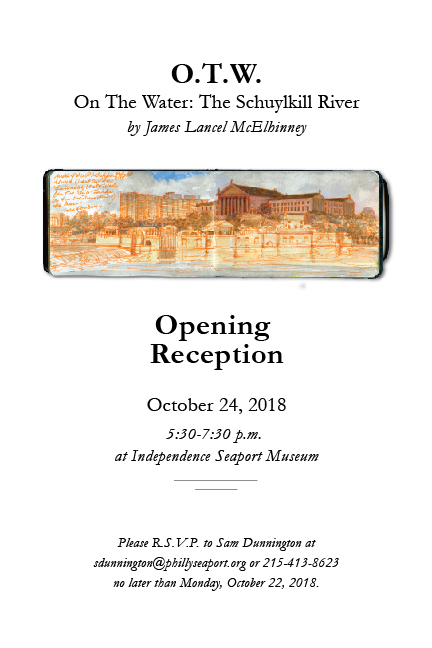
With Chief Curator Craig Bruns (sporting the official O.T.W. ball-cap) just minutes before the reception.

Independence Seaport Museum President, the amazing John Brady, addressing reception attendees
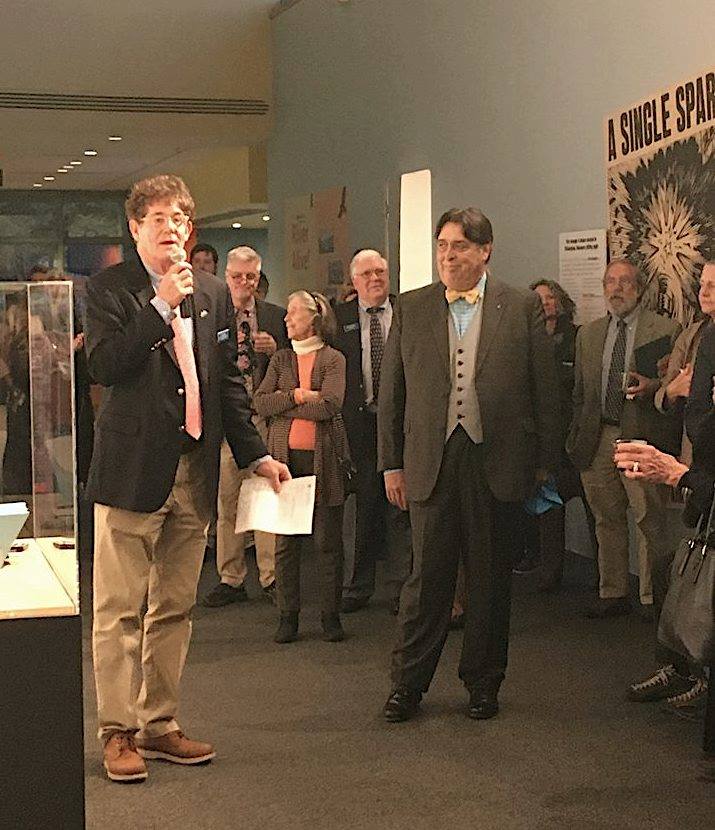
Philadelphia painter and essayist Nancy Bea Miller wearing the official O.T.W. ball-cap. On a whim I had a Garment District hat-maker produce several dozens of these items in the city colors: sky-blue and gold. Knowing that art-openings can be fraught with a self-serious lack of spontaneity, I distributed these caps at the reception as party favors.It worked. The rest of the evening was fun and festive.

Now Available: 1986 Philadelphia Color Intaglio Print by James Lancel McElhinney
In 1985 James Lancel McElhinney was commissioned by Gross-McCleaf Gallery in Philadelphia to design a three-color etching and aquatint that was produced in a limited by master-printer Cindi Royce Ettinger. Based on a painting from an urban landscape series entitled “A Part of the City”, the image represents the view looking north from the artist’s residence on Fulton Street. It is one of the only winter scenes in the series. Published in the summer of 1986, most of the prints were gone within a year.

Six copies have recently come to light, part of the artist’s share of the edition, which had remained in the archives of master-printer Cindi Ettinger for the past 32 years.
The artwork was printed in color with three plates on Rives BFK Heavy grey paper.
Sheet size is 22 x 30 inches. image size is 12.75 x 13.625 inches.
Signed and dated by the artist.
Retail price: $1,200.00
Please enquire to: editions@needlewatcher.com
KILAUEA-KULANIAPIA Painting-Journal on view at The Institute Library in New Haven. (Downloadable PDF at the bottom of this post)

James Lancel McElhinney’s painting-journal Kilauea Kulaniapia will be on view at the Institute Library in New Haven, from June 7-August 31, 2018, as part of the library’s summer exhibition Wish You Were Here: Journals, Journeys & Expeditions, organized by Martha Willette Lewis, artist, curator, and host of Live Culture on Radio WPKN.


On June 30, 2015 McElhinney arrived in Hilo to participate in a series of programs at the University of Hawai’i at Hilo. On July 1, he accompanied a group of students and faculty to Kilauea Military Camp, near the summit of the volcano. Using the USGS summit-marker as an easel, around 13:00 hours McElhinney began work on a series of journal paintings through the night. A few months prior, the central pit of the crater had erupted, flooding the wide expanse of the crater. The southern arc of the rim road had been closed when lava flows had breached the perimeter. On the night of June 30-July 1, 2015 clouds of toxic gas rose up from the fiery pit, illuminated by its orange glow




Following the night on Kilauea, McElhinney and his wife, art-historian Katherine Manthorne traveled from Kilauea to Hunalu’u, famous for its black sand beaches, before heading north toward Kona on the western side of the island, to return to Hilo via the Saddle-Road. Subsequent road trips around the island included visits to the refuge at Pu’uhonau Honaunau and Kealakekua Bay—site of the skirmish in which British explorer Captain James Cook was killed in a scuffle over a stolen rowboat.

Further excursions took McElhinney & Manthorne to the chapel at Kahua Ranch, north of Waimea, where muralist Jean Charlot had painted a small fresco. Lava Tree park, Omea Falls, Onomea Bay, and Kulaniapia Falls were among their other destinations. Many of these trips were recorded in McElhinney’s sketchbooks. The final journal-painting of the trip was produced under the Banyan trees at Liluokalani Park in Hilo.





PDF:KILAUEA KULANIAPIA_Fact Sheet
Press release and invitation to Wish You Were here, opening 6-8 pm, June 7, at The Institute Library, 847 Chapel Street, New Haven, Connecticut. 06510
Invitation: wish evite w info (take 2)
Press Release: Wish You Were here pr 3
Kilauea Kulaniapia and other works are available for purchase at Gerald Peters Gallery Santa Fe. Interested parties please contact Maria Hajic. 505-954-5769. mhajic@gpgallery.com,
THE ROCKIES AND THE ALPS OPENS SATURDAY MARCH 24 AT THE NEWARK MUSEUM

PRESS RELEASE: rockies and alps_vantage points_press release
IMAGE PREVIEW: The Rockies and the Alps Image Set _a
BEHIND THE SCENES INSTALLING THE SHOW AT NEWARK MUSEUM:

Curators Patricia Bloom (left) and Kathie Manthorne (right)


Testing the digital Magic Lantern show



REBUILDING CAREERS: ARTIST LEGACY PROJECTS
[caption id="attachment_407" align="alignnone" width="300"] James L. McElhinney depositing the papers of Bernard Chaet into the Smithsonian Archives of American Art
James L. McElhinney depositing the papers of Bernard Chaet into the Smithsonian Archives of American Art

Studio of Francis Bacon

James L. McElhinney with Mobius by Masami Kodama,at the James A. Michener Art Museum
What becomes of an artist’s reputation when their working life comes to an end? We are in the midst of a sea-change in the creative arts, as time, technology and a rapidly changing marketplace have changed for rules for how artworks find their way from studios into collections. Apart from artist-estates endowed with vast resources and sound financial investments, significant achievements by underfunded artist-estates will be forgotten. One might argue that the marketplace is where an artist must prove their mettle, but time and again we find evidence to the contrary. In the late nineteenth century, one could buy every Vermeer in existence for the price of a Highland Stag by Sir Edwin Landseer. Without financial support from his brother, Vincent van Gogh would have been unable to produce his remarkable body of work. His legacy might have been forgotten completely, were it not for the tireless efforts of his sister-in-law, Johanna van Gogh Bongers, to promote his work. This she did, as a single mother without vast wealth, for more than a decade. She remarried but was widowed again. When Johanna died in 1925, she was still at work, translating Vincent and Theo’s letters into English.


Johanna Bonger Van Gogh and her son, Wilhelm Vincent. 1890
When an artist becomes incapacitated, or passes away, how are their heirs to manage the material aspects of the estate? Lawyers and accountants are necessary, but also limited in their knowledge of how art is preserved, valued and celebrated. They will be faced with a lifetime’s accumulation of artworks and papers, often with no guidance as to how best to organize and preserve them. Where might an archive be sold, or donated? Is there still a market for the artwork? Can it be reinvigorated? The answer of course is yes. Johanna van Gogh may have faced tremendous challenges, but we must remember that her late husband had been an art dealer. Through his former employers and associates she had access to good advice, as demonstrated by her ultimate success.
Here is a road-map to get you started.
For a free consultation, please feel free to contact us at info@needlewatcher.com, subject line “Legacy”
Michener Art Museum Acquires Important works by WPA/AbEx Artist Hugh Mesibov (1916-2016)
[caption id="attachment_357" align="alignnone" width="300"] “The Hunt” by Hugh Mesibov. Acrylic on Canvas. 78 x 116 inches
“The Hunt” by Hugh Mesibov. Acrylic on Canvas. 78 x 116 inches
The Michener Art Museum in Doylestown, PA, has just acquired a major painting and a series of Mesibov’s prints and drawings from the WPA era. Raised in Philadelphia, trained at the Pennsylvania Academy of the Fine Arts, Mesibov gained national attention during the 1930s, when he, Dox Thrash and Michael Gallagher developed the technique of Carborundum printing. It was a golden age for Philadelphia printmaking, led by more senior artists like Wharton Esherick and Benton Spruance.
The gift was facilitated by Needlewatcher LLC Artist Legacy Projects estate planning and management services.
The Hunt by Hugh Mesibov is now on view, at the Michener Art Museum, 138 South Pine Street, Doylestown PA 18901
HUGH MESIBOV (1916-2016) FEATURED IN NEW SHOW AT ZIMMERLI MUSEUM AT RUTGERS

Hugh Mesibov. Nocturne. 1942. 7 x 10 1/4 (17.8 x 26.0 cm) 71.8 inches. Color serigraph on Paper
A win for the Hugh Mesibov estate, and for Needlewatcher LLC, which facilitated the loan of this work to this exhibition.
Read the whole article in ArtDaily news:
http://artdaily.com/news/98607/Zimmerli-examines-lesser-known-legacy-of-the-WPA#.WbAm9DOZOCQ
Professional Development Lectures at Greenwich Art Society: “A Fly on the Wall: Re-envisioning a Life in Art” with James Lancel McElhinney. October 5, 2017

On Thursday evening October 5, Pollock-Krasner grant recipient James Lancel McElhinney will deliver one of several professional-development lectures being presented by the Greenwich Art Society. McElhinney will unpack his experiences as a visual artist, author and now publisher. His talk will identify challenges facing artists today, and propose concepts for addressing them.
Read the article in today’s Greenwich Sentinel:
https://www.greenwichsentinel.com/2017/09/02/g-a-s-offers-lecture-series-to-help-professional-artists/
Program description:
A FLY ON THE WALL_JamesMcElhinney_(c)2017
Oral History Project: Conversations with Gendron Jensen and Christine Taylor Patten


On April 19, James McElhinney completed in-depth oral history interviews with Gendron Jensen and Christine Christine Taylor Patten, who delivered wonderful narratives about art, transformation and the power of drawing. The audio files are being transcribed for reading. At some point in the future these conversations may be published, or be accessible through those institutions where Christine and Gendron’s papers will ultimately reside.
An oral history is the keystone document to any archive. Many researchers will begin by consulting the oral history because it provides a sweeping overview of an artist’s life. Producing artwork and gaining recognition are only the beginning. The real challenge that awaits every artist is assuring that their work will have a durable legacy. Forming an archive is essential because if the future cannot find you, you were never here.
Concept and Painting: A Conversation with Robert C. Morgan

Robert C. Morgan is an internationally renowned critic, artist, poet, historian, educator and author of the book The End of the Art World. Concept and Painting, an exhibition of the artist and critic Robert C. Morgan is now on view at Proyetos Monclova in Mexico City. The show opened on March 23rd and runs through April 29.



I first met Robert when we both taught on Fridays at Pratt Institute in Brooklyn. We were in different departments, but at midday we each went off campus for lunch. On one of those days, we found ourselves at a restaurant, waiting for dining companions who never arrived. Rather than dining alone, we began a series of conversations, of which this is the latest. On Friday April 7, I sat down with Robert at his home near Union Square to learn more about the exhibition.
Listen to our conversation:
Comments are welcome below, where you can share this on social media and request notification of future podcasts and blog posts
Conversation with Artist Sigmund Abeles
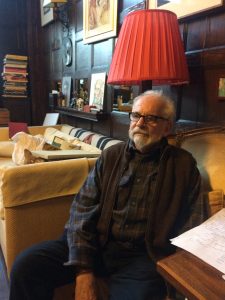
Over the last two weeks I collected a series of conversations with Sigmund Abeles for the Jewish Heritage Oral History Archives, in the Addlestone Library at the College of Charleston. The audio recordings will be available in the future through the Lowcountry Digital Library.
I fist met Sigmund Abeles in the late 1970s. My then wife Vicki Davila and Sig’s then wife Frederike Merck had been room-mates in Pietrasanta, where both had been studying stone-carving with local artigiani. Over the years we have maintained a warm friendship, and shared a great passion for drawing. We both identify with a Northern esthetic–the figurative German and Netherlandish tradition that favors sharp tools and articulate line.
We spoke of his undergraduate days at University of South Carolina, graduate school at Columbia University, fresco-painting at Skowhegan School of Painting and Sculpture and the Art Students League of New York. Unpacking stories about his career as a draftsman, printmaker, painter and sculptor, he described also the perils of being so diversified in an art-market built on backing brands. Abeles taught in a number of colleges and universities, finally retiring from the University of New Hampshire. The conversation mentioned artists whose names today are less well-known; artists such as Leonard Baskin, Michael Mazur, Harold Tovish, Marianna Pineda, Sidney Hurwitz, Hyman Bloom and Rico Lebrun, whom Sig quoted as saying, “If one has nothing to say, they gossip. If one has nothing to draw, they sketch.”
Resisting pressure to work abstractly, or bow to formalist figuration, Sig’s work embraced narrative, social commentary, eroticism and equestrian subjects. Manifested in visual form, as representational imagery, these works represented a departure from his paternal roots in Orthodox Judaism. He discussed his activities within the National Academy of Design, the Century Association, the New York art-world and his beloved children, one of whom–Max Abeles–is making a name for himself as an artist.
Part of our discussion did address his experience of growing up Jewish in Myrtle Beach, South Carolina, his association with the Civil Rights movement that led to his expulsion from the University of South Carolina, standing up to the Klan, and later in life being courted by USC as a Native Son. We spoke of his friendship with Jasper Johns–another South Carolinian, and his first exposure to art at Brookgreen Gardens, which now owns some of his work.
It may come as a surprise that the largest Jewish population in the antebellum United States was not in New York or Philadelphia but in Charleston, followed by New Orleans, Mobile and Savannah. As many as ten thousand Jews saw military service during the Civil War, during which General U.S. Grant ordered all Jews to be expelled from Tennessee, Kentucky and Alabama. Judah P. Benjamin served as Secretary of War and Secretary of State for the Confederacy. Its surgeon-general was Simon Baruch, from South Carolina. The first Jewish governor of any American state was David Emanuel, a captain of militia during the Revolutionary war.
A second interview conducted by Dale Rosengarten, Curator of Special Collections at the College of Charleston, will focus on Sigmund Abeles’s Jewish identity.
The value of collecting these conversations is to preserve the voices and ideas of significant artists like Sigmund Abeles whose creative legacy, despite a distinguished career, might otherwise be forgotten. Artists born in the 1930s, ’40s and ’50s are advancing in years. Many have diminished their output, and have been marginalized by shifting trends in the art-market.
Oral history interviews collected by the College of Charleston, the Archives of American Art, the Senior Artists Initiative in Philadelphia, the Frick Center for Oral History and many other organizations become keystone documents–primary sources for researchers to consult, and from which artists and others might draw inspiration.
James L. McElhinney
PIONEERING 1997 STUDY INTO VISUAL ARTIST ESTATE PLANNING
In April 1997 the Judith Rothschild Foundation and the Marie Walsh Sharpe Foundation co-sponsored a conference on Visual Artists Estate Planning, which led in 1998 to the publication of a very useful book, A Visual Artist’s Guide to Estate planning. In the ensuing nineteen years, more and more artist estates have created foundations and trusts to support the creation, exhibition, publication and study of visual art. A softcover edition of the book is available from a number of online and bricks-and-mortar booksellers. A free downloadable PDF of the book was located online. More and more information about this challenging subject is becoming available. One thing is certain. Without an estate plan and the creation of an archive to establish durable reference value of an artist’s life and work, that life will disappear from history. If the future cannot find you, you were never here.
RE-EMERGING WPA ARTIST-ABSTRACT EXPRESSIONIST. Monumental Mural by Hugh Mesibov on view at Yeshiva University Museum. Public reception October 26, 2016. 6-8pm

On December 4, 2012, oral historian James McElhinney and Chelsea Cooksey traveled to Rockland County, New York to collect an interview with American expressionist painter and printmaker Hugh Mesibov, for the Smithsonian Archives of American Art. He had recently celebrating his 97th birthday.

Hugh Mesibov (1916-2016)
Born, raised and trained in Philadelphia, Mesibov was very active in the Works Progress Administration during the 1930’s, painting canvases, murals and inventing new printmaking techniques. Later, during the 40’s he moved to New York City, where he became a member of The Club – an informal artists’ union that famously met at the Cedar Bar when Abstract Expressionism was in its heyday. Mesibov became close friends with Franz Kline and Ibram Lassaw.
In 1960 he moved his growing family to an old house in Rockland County; the home where McElhinney, assisted by Cooksey, met with him over the course of two days, years later. Hugh Mesibov passed away in March of 2016. A few months after Hugh’s death I was invited by the Mesibov family to help them to establish a durable artistic legacy. This began with an assessment of his papers and artworks.
Already in the works was the pending gift to Yeshiva University Museum by The Reform Temple of Rockland County of a major mural by Mesibov, The Book of Job, which had been commissioned in 1969 by Temple Beth-El in Spring Valley, New York. Mesibov’s reputation as a Modernist painter was known to the congregation, which requested that he approach the mural depicting the Book of Job with a more traditional style. In preparing to execute this massive canvas, Mesibov was able to draw on the skills he had learned working under the WPA. The painting was completed in 1972.
You are invited to attend a reception to celebrate the donation of this major work by a re-emerging American master on Wednesday October 26, at the Popper Gallery of Yeshiva University Museum, 15 West 16th Street, 10011.
A reception will be held in the Popper Gallery at the museum on Wednesday October 26, from 6-8pm. The mural will remain on view through January 15, 2017.

An Interview with Bo Bartlett

On Sunday July 3, 2016 I sat down with noted painter Bo Bartlett to discuss the genesis and operations of the Bo Bartlett Center at Columbus State University in Columbus, Georgia. What I discovered was an unusual example of artist-philanthropy; a collaboration between Bartlett, his patrons and his hometown university on a mission to enrich the community and health its maladies. The interview appeared in the American Arts Quarterly.
–James L. McElhinney
PDF of the membership form for anyone wishing to support its work:
ARTS LEGACY PROJECTS UPDATE: Kodama sculpture donated to the Georgia Museum of Art
Masami Kodama was born in 1936, studied art in Kyoto, came to the United States nearly fifty years ago, and retired to his native Higashi-Hiroshima in 2011. His patrons included the late John and Kimiko Powers and the late Edward Rosenthal, founder of Time-Warner Media. For many years Mr. Kodama was represented by Weintraub Gallery, and more recently by Lew Allen Contemporary in Santa Fe. His work is found in many public and private collections including Lincoln Center, the Metropolitan Museum of Art and the Michener Museum in Doylestown, PA. When he left the United States to return to Japan, Mr. Kodama withdrew his work from galleries, leaving some of it with a group of friends authorized to make donations of art work to American museums, as a way of expressing thanks for so many years of success.
This is the most donation of a Kodama sculpture to an American museum.

ARTS LEGACY PROJECTS: HELPING ARTISTS AND THEIR HEIRS

When an artist reaches the end of his or her working life, their family, friends and heirs are often uncertain about how to manage the accumulation of papers and artworks that represent an artist’s life in art. We can provide a roadmap for how to organize and deploy these holdings, while providing expert guidance and skilled assistance in placing papers, letters, photographs and journals in researcher-friendly public archives, making strategic donations of artworks to museums and other public institutions as steps toward creating durable creative legacies for artists who have passed their productive years.
For more information, please contact us at info@needlewatcher.com
VOICES IN CONTEMPORARY ART (VoCA) Artist Interview Workshop at the Denver Art Museum, June 15-16, 2016

On Wednesday June 15 at 6pm, the Denver Art Museum in cooperation with Voices in Contemporary Art (VoCA) will present artist and oral historian James Lancel McElhinney in conversation with American Artist Marie Watt (b. 1967) whose work draws from history, biography, proto-feminism, and Indigenous principles, addressing the interaction of the arc of history with the intimacy of memory.
She uses materials that are conceptually attached to narrative: in particular, exploring the stories connected with commonplace woolen blankets, cedar, and iron

CURRENTS AND CONFLUENCES: ARRIVALS
Today Edgar Hock Aye Vi Heap of Birds touched down at Key West and will begin installing his portion of the exhibition. He will also conduct an intervention into the City of Key West with a series of Native Hosts/Tribal Panels Here are Edgar and The Studios of Key West Executive Director Jed Dodds earlier today

CURRENTS AND CONFLUENCES: A SYMPOSIUM OF ART AND IDEAS
March 3-6, 2016. Featuring an exhibition of artworks by Edgar Heap of Birds, Aurora Robson and Frederick Brosen. Keynote lecture by Dr. Katherine Manthorne with guest speaker Dr. Margaret Vendryse, art history sessions led by Dr. Jillian Russo, public conversations with featured artists, workshops, field trips, films and a surprise guest. 



